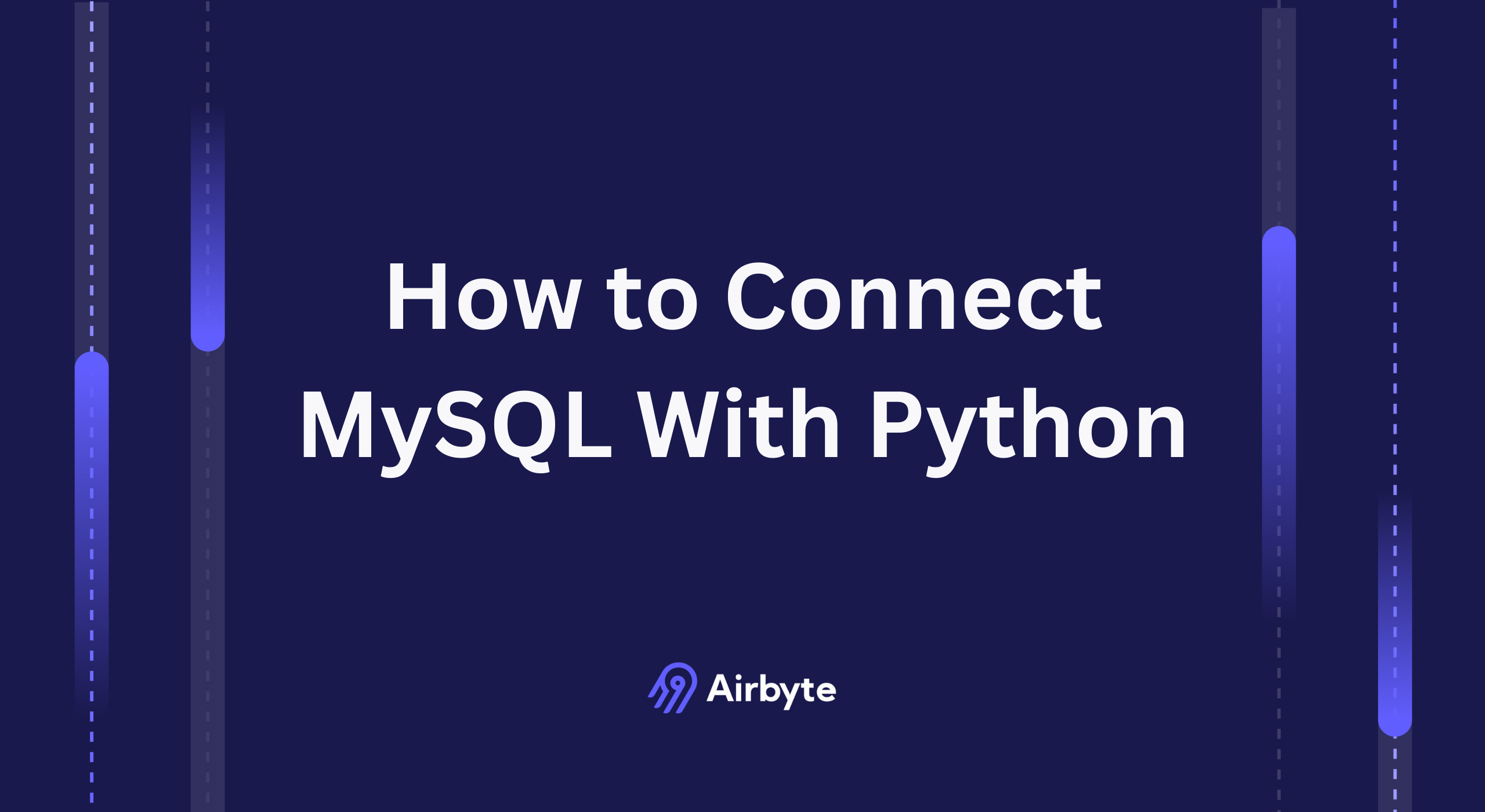How to Connect MySQL With Python: 2 Methods
Summarize this article with:
✨ AI Generated Summary
MySQL and Python integration faces challenges like connection instability and performance issues, which can be mitigated using the official MySQL Connector/Python or Airbyte's data integration platform. Key points include:
- MySQL Connector/Python supports multiple cursor types, connection pooling, advanced authentication, and async operations for scalable, secure applications.
- Common use cases span data analysis, web development, real-time processing, and machine learning pipelines.
- Advanced connection management techniques such as pooling, asynchronous patterns, health monitoring, and robust error handling improve reliability and performance.
- Airbyte offers an AI-enabled, open-source platform with PyAirbyte for simplified, automated MySQL data integration, supporting change data capture and schema evolution.
- Choose MySQL Connector for fine-grained control and Airbyte for streamlined, enterprise-grade data workflows depending on project needs.
MySQL and Python represent a powerful combination for data-driven applications, yet many developers struggle with connection instabilities, performance bottlenecks, and security vulnerabilities that can compromise production systems. Recent industry analysis reveals that 73% of developers encounter recurring integration challenges despite available libraries, primarily due to undocumented environmental dependencies and configuration nuances.
This article explores proven methods for establishing robust MySQL-Python connections while addressing common pitfalls that derail integration projects. You'll discover two effective approaches: the official Python connector for MySQL and Airbyte's comprehensive data integration solution. Additionally, you'll learn advanced techniques for connection management, performance optimization, and error resilience that ensure production-ready implementations.
What Is Python MySQL Connector?

MySQL Connector/Python is an official library developed by Oracle to enable interactions between Python applications and MySQL databases. It allows developers to execute SQL queries, manage database transactions, and retrieve or manipulate data using Python scripts. The connector complies with the Python Database API Specification v2.0 (PEP 249) and depends only on the Python Standard Library.
The connector provides both pure Python and C extension implementations, offering deployment flexibility for different environments. The pure Python version requires only Protobuf libraries and works across all Python-supported platforms, while the C extension delivers enhanced performance through native compilation. Recent versions include advanced authentication mechanisms like OpenID Connect integration and enhanced SSL certificate validation for enterprise security requirements.
MySQL Connector/Python supports multiple cursor types including dictionary cursors for JSON-like data handling, prepared statements for performance optimization, and connection pooling for scalable applications. The library maintains compatibility with MySQL 5.7+ and MariaDB while providing seamless integration with modern Python frameworks and async libraries.
What Are the Primary Use Cases For Connecting MySQL With Python?
Once the connection is established, the MySQL connector allows you to perform CRUD (Create, Read, Update, Delete) operations on databases, fetch data into Python, and leverage other libraries to execute various data-driven tasks. Typical use cases include:
Data Analysis and Visualization
You can extract specific datasets from MySQL and manipulate them with libraries such as Pandas and NumPy. After transforming the data for in-depth analysis, libraries like Seaborn or Matplotlib help create visualizations like graphs, charts, and more to uncover trends and patterns. Modern implementations often incorporate connection pooling to handle large dataset extractions efficiently while maintaining query performance through optimized indexing strategies.
Web Development and APIs
Connecting MySQL with Python lets you build dynamic web applications that use MySQL as the backend database. Python frameworks like Django and Flask simplify web development and make it easy to create RESTful APIs that issue SQL queries via the connector and return results over HTTP. Production deployments typically implement connection pooling with health checks and retry mechanisms to ensure API reliability during high-traffic periods.
Real-Time Data Processing
Python applications can leverage MySQL's change data capture capabilities for real-time data processing workflows. This approach enables event-driven architectures where Python scripts automatically respond to database changes, triggering downstream processes like cache updates, notification systems, or analytical pipeline refreshes. Modern implementations often combine MySQL triggers with Python's asyncio capabilities for non-blocking event processing.
Machine Learning and AI Applications
MySQL serves as a robust data repository for machine learning pipelines where Python scripts extract training datasets, perform feature engineering, and store model results. Advanced implementations utilize vector data types for similarity search in AI applications, while connection management strategies ensure consistent data access during model training and inference phases.
How to Connect MySQL to Python Using Connector?
To connect MySQL to Python with the Connector/Python library, install the library, import it, and establish a connection with your database credentials.
Installing MySQL Python Connector
mysql-connector-python is the driver Python needs to access MySQL. Assuming pip is available, install the connector:
pip install mysql-connector-python
For production environments, consider specifying exact versions to ensure consistency across deployments:
pip install mysql-connector-python==8.0.32
Verify successful installation by checking the connector version:
Import the Connector Module
After installation, import the module along with essential error handling classes:
The Error class enables comprehensive exception handling, while pooling provides connection pooling capabilities for scalable applications.
Establish the Connection
Supply your connection details with comprehensive configuration parameters:
For enhanced security in production environments, implement SSL connections:
Once connected, verify the connection status before executing queries:
How Can Advanced Connection Management Improve Performance and Reliability?
Effective connection management represents a critical factor in production MySQL-Python applications. Traditional single-connection approaches create performance bottlenecks and reliability vulnerabilities that sophisticated connection strategies can eliminate.
Connection Pooling Implementation
Connection pooling maintains a cache of reusable database connections, dramatically reducing connection establishment overhead. The mysql.connector.pooling module provides configurable pools that optimize resource utilization:
Pool sizing should align with expected concurrency patterns. Web applications typically benefit from pool sizes matching expected simultaneous users, while batch processing applications might require larger pools to handle parallel operations effectively. Monitor pool exhaustion through connection wait times and adjust sizing accordingly.
Asynchronous Connection Patterns
For applications requiring high concurrency, asynchronous database operations prevent blocking during I/O operations. The aiomysql library provides async-compatible MySQL connectivity:
Asynchronous patterns enable handling thousands of concurrent database operations without thread overhead, making them ideal for real-time applications and high-throughput APIs.
Connection Health Monitoring
Production applications require connection validation to prevent failures from stale connections. Implement health checks with automatic reconnection:
Configure connection timeouts to handle network instability gracefully. Set connect_timeout=10 for connection establishment and read_timeout=30 for query execution to prevent indefinite blocking during network issues.
What Are the Essential Error Handling and Reliability Patterns?
Robust MySQL-Python applications require comprehensive error handling strategies that distinguish between recoverable and permanent failures while implementing appropriate retry mechanisms.
Structured Exception Handling Framework
MySQL operations generate various exception types requiring specific handling strategies. Implement layered exception handling that addresses each category appropriately:
Transaction Management and Recovery
Implement robust transaction management with automatic rollback capabilities for data consistency:
Circuit Breaker Pattern Implementation
For applications facing intermittent MySQL availability issues, implement circuit breaker patterns that temporarily suspend database operations during outages:
This pattern prevents cascading failures by temporarily blocking requests to an unhealthy database while allowing periodic recovery attempts.
How to Connect MySQL to Python Using Airbyte Solutions?
Airbyte is an AI-enabled data-integration platform that offers an open-source Python library, PyAirbyte, for working with Airbyte connectors in Python. It enables you to extract data from hundreds of sources and load it into SQL caches such as Postgres, Snowflake, and BigQuery with ease.
Airbyte provides comprehensive MySQL integration through multiple approaches. The Airbyte Cloud platform includes a pre-built MySQL connector with change data capture capabilities, while PyAirbyte enables programmatic data integration within Python applications. After centralizing your data using Airbyte's integration capabilities, you can connect to the resulting datasets using any MySQL connector for Python.

Airbyte's Advanced MySQL Integration Capabilities
Airbyte's MySQL connector supports sophisticated replication scenarios including binary log-based change data capture for real-time data synchronization. This capability enables Python applications to access near real-time data changes without impacting source system performance. The connector handles schema evolution automatically, ensuring Python applications continue functioning when database structures change.
Key Airbyte features that streamline database work include:
PyAirbyte Integration Example
PyAirbyte simplifies data extraction from MySQL sources with minimal configuration:
This approach provides automatic schema detection, incremental loading, and state management without requiring manual connection handling or SQL query construction.
Why Use PyAirbyte?
PyAirbyte offers several advantages for MySQL-Python integration projects:
PyAirbyte eliminates much of the complexity associated with direct MySQL connector management while providing enterprise-grade capabilities for data integration workflows. The platform handles connection pooling, error recovery, and schema evolution automatically, allowing developers to focus on business logic rather than infrastructure management.
Final Thoughts
Establishing robust connections between MySQL and Python requires careful consideration of performance, reliability, and security requirements. The official Python connector for MySQL provides direct database access with fine-grained control over connection parameters and query execution. Advanced techniques like connection pooling, asynchronous operations, and comprehensive error handling ensure production-ready implementations that scale effectively.
Alternatively, Airbyte provides an end-to-end data integration solution that simplifies MySQL connectivity while adding enterprise-grade capabilities for change data capture, schema evolution, and multi-destination replication. PyAirbyte particularly excels in scenarios requiring rapid development, automated data pipeline management, and integration with modern AI/ML frameworks.
Choose the method that best aligns with your infrastructure complexity, performance requirements, and development timeline. For direct database operations with maximum control, implement the MySQL connector with advanced connection management patterns. For comprehensive data integration workflows with minimal operational overhead, leverage Airbyte's managed capabilities while maintaining Python application flexibility.

.webp)
